Three hours west of Sydney, beyond the touristy Blue Mountains, lies Oberon: a fairy tale land of pine plantations and rolling hills, that in the autumn months become a place of pilgrimage for mushroom gatherers and East Europeans searching for a piece of home.
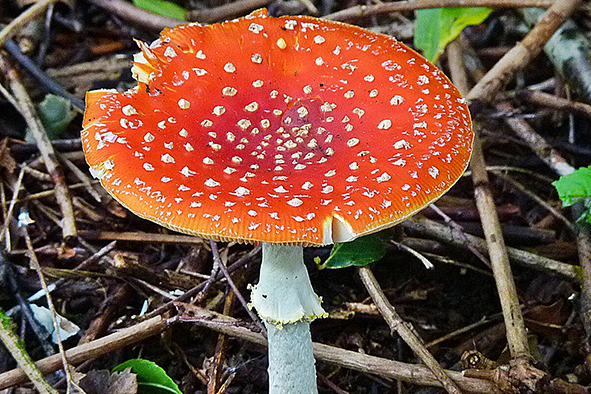
A fly agaric – not for eating! (Photo: caztar via Flickr)
Any first-time mushroom forager should, if they can, contract the help of a competent guide. Mine was named Konrad, a Polish-Australian and a part-first, part-second generation immigrant— his family arrived in Sydney when he was a child and the accents of the Old Country still sat heavy on Konrad’s tongue.
He had already proven a near-magic affinity with the Oberon, finding my campsite despite very vague instructions – “I’m in a sort of oval-ish clearing, surrounded by, um, pine trees, just off from the road.” But then the Oberon is a hybrid too: half European farmland, half Australian bush. The grass there is English green under southern light, and the unruly copses of sinuous gums contrast with the regimented pine plantations, which throw a dark patchwork across otherwise well-grazed hills.
It was still early when Konrad arrived – one has to come early when mushroom foraging, for the crop, which grows overnight, is harvested fast. He and his extended family (parents, wife, and kids) bounced into the dank clearing in an overladen people carrier. They had already driven the three hours from Sydney, while I was barely out of my tent, cradling a mug of camp-stove coffee and inspecting one of the red and white toadstools that ringed the edges of my camp.
Konrad got out of the car. Tall and tanned, with wholesome good looks, he was also wearing a particularly silly pointed hat and sported a heavy moustache. He looked like a surfer impersonating a gnome.
“So I guess these are ‘bad mushrooms’,” I said, indicating the toadstools near my tent.
“The fly agarics?” said Konrad. “No, they’re not bad. Well, they won’t quite kill you, if that’s what you mean. And some people do eat them, but not because they taste nice.”
“You mean they’re… magic?” I asked, suddenly wondering if this was going to be a very different kind of trip than the one I had planned.
“Not in the fun sense,” Konrad laughed. “They’re about as psychotropic as a bad case of the flu. But there are shamans in Siberia who eat them then offer their urine as a drink to the tribe. It filters out the mushroom’s toxicity and ups the power of the hallucination.”
“Oh…” I said, thinking how that didn’t sound like a process I’d like to participate in at either end. “We’re not going to do that, though, are we?”
“Only if we’re too late for the tasty mushrooms,” Konrad winked. “So, come on. Pack up your tent, time to get going.”
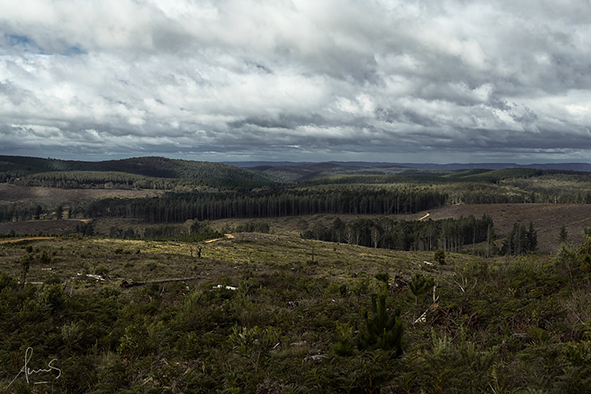
Dappled light over the Oberon (Photo: Sacha Fernandez via Flickr)
Of fungi-philes and fungi-phobes
Wild mushrooms are among the world’s most divisive foods. In Konrad’s – admittedly quite extreme – opinion, the world was made up of two kinds of people: the fungi-philes and the fungi-phobes; either you obsessed over mushrooms, he said, or you were scared of them.
Which camp a person falls into, Konrad told me, was often a question of upbringing and culture, meaning that in a country like Australia – a nation of immigrants – mushroom foraging is far more than just a search for food; it’s an expression of heritage. So when the cooler days of autumn hit and Sydneysiders with Slavic ancestry like Konrad and his family head west to look for mushrooms, they are doing so to commune with their roots. The Oberon and its forests become a symbol of their homelands.
Into the manmade woods
Leaving my campsite behind, we headed back into the rolling expanses of the Oberon. The landscape was still pocketing morning fog, though above was a sky of luminous, Australian blue. It was cool and there was a nourishing moistness in the air: perfect conditions for mushroom cultivation.
We headed for the Vulcan Forest, the largest pine plantation in the region. The trees there are Californian Radiata Pines, the mushrooms a happy coincidence of farming. They are, strictly speaking, non-natives – a dirty word in Australia – yet despite the American-ness of the trees there was a sense when we entered the plantation that we were also entering Europe, so questions of what belonged there became moot.
The Vulcan Forest was swaddled in a fog bank, and as we drove into it the world closed, white about us, so that we could no longer see the treetops and made looking out between their trunks like peering through the half-vision of a dream. A heated discussion began between Konrad and his family as to where was the best place to stop. It seemed a strange argument, given the world we had entered, in which every square metre appeared the same. But then, they had been doing this for years, I figured, and must have their preferred hunting grounds, regardless of whether they are chosen from superstition or experience.
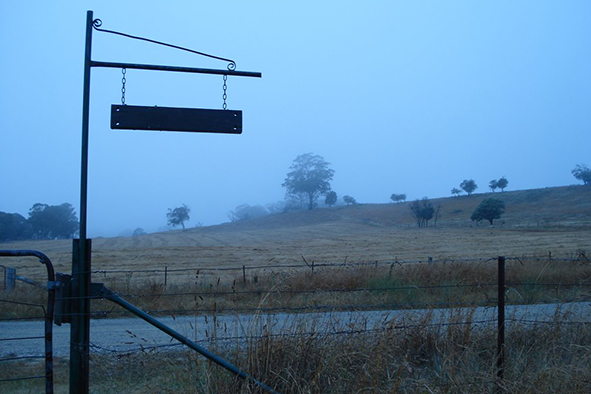
The Oberon in fog (Photo: David Ansen via Flickr)
Eventually we pulled over, Konrad cut the car’s engine and silence descended: the silence of a foggy pine forest just after dawn. The mushrooms we were looking for, I was told, were saffron milk caps and slippery jacks: no others. I was led into the forest, wicker basket in hand, to be shown just what these two fungi look like. Wicker baskets are essential, Konrad told me; they allow mushrooms to spread their spores even after they’ve been picked.
I was startled by just how quickly we found examples of both edible fungi. The first, the saffron milk cap, were sizeable, dry, and orangey white. Konrad demonstrated how their gills bleed day-glow orange when cut. Slippery jacks were far less appetising: as slimy as their name suggested, they were brown and looked every centimetre the feeders on putrefaction that they are. In short, they seemed exactly the kind of things that my mother always taught me not to touch. Konrad assured me that they were very tasty.
“Just whatever you do don’t pick anything white,” he warned me. “The white ones are deadly.”
And with that he left me to start foraging on my own.
It was a slow, meditative experience. The world shrunk down even smaller than the fog-thick forest, to where I only cared about the half metre of pine-carpeted earth directly at my feet. Every sound was muted, from my footsteps to the distant alien bird song that chirped softly through the trees. I could both see and hear my own breath. My hands were cold. I felt isolated, but not unpleasantly so.
I had filled almost half my basket when I realised that there was no longer anyone around; I was lost. Every direction looked identical: rows of pine trees slowly fading into fog. I had no idea even which way it was to the road, whether it was near or far; even the concept of the road suddenly felt like an unreliable memory. The forest had become a dreamscape outside of ordinary space and time.
Just as I started to consider calling for help, though, I heard voices on the air. They were not speaking English but some kind of Slavic. Another family of mushroom foragers emerged from the fog. They were Ukrainian-Australians, also in the forest looking for home. With their help, I discovered that I was mere metres from the road.
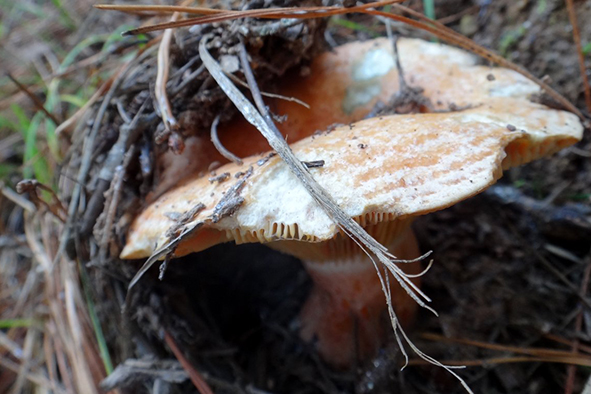
A saffron milk cap mushroom on the forest floor (Photo: Ian Sutton via Flickr)
Stick another mushroom on the barbie
We headed to several other mushroom gathering spots around the Vulcan Forest that day. And even if I could not understand why they were chosen, I didn’t ask questions. Konrad was an exceptional, almost too enthusiastic, guide. He would grab every mushroom he could from the forest floor – however hideous – probe at its skirts then describe its properties and character to anyone who cared to listen, lamenting inedibility when he found it, which was often. I began to get the feeling that a big part of being a mushroom expert is a strange desire to eat your object of study, even when you know categorically that you cannot.
I accept that not everyone can be as lucky as I was in finding a guide like Konrad, and for them the best thing is to do is head into the town of Oberon itself, to collect a mushroom guidebook from the visitor’s centre. They also offer a checking service there at the end of the day to make sure the mushrooms you’ve gathered are safe for eating.
By the time the fog patches had been burned off by the early autumn sun, our baskets were filled, and the eating could begin. In this, a more Australian side to Konrad’s family surfaced, as we drove back into Oberon town where municipal barbecues were waiting.
I sat down with Konrad’s mother to slice and clean mushrooms. In the glorious warmth of the afternoon sun I talked to her about Europe: about how sometimes she longed for grey skies and how in the village of her childhood the mushroom seller’s cart used to be positioned right next to a man who still sold leaches as a medical cure.
“It was a different place, a different time,” she said in strongly accented English, as she sliced at mushrooms she’d picked from the forest floor that morning.
Konrad then produced a cool box (or eskie as they’re called Down Under) from the back of his people carrier, and from it came herbs, butter, garlic and chilled Chardonnay. Soon everyone had a beaded glass in hand, the picnic benches became a kitchen of chopping, crushing and conversation. The language used switched from English to Polish and back again, as personal cooking techniques were argued over, and the wonderful tastes of mushrooms were talked up and discussed. Then the barbecue was fired up.
A couple of glasses of wine down, and clearly excited that the moment had almost come for putting mushrooms in his mouth, Konrad had again started up on his favourite topic for conversation:
“Of course mushrooms aren’t animals,” he told me, “but they’re even less like plants. In fact they’re like no other kind of life form on earth. There’s even speculation among some of the more extreme fringes of the fungi enthusiasts community that they’re not from earth at all. That their spores arrived across space.”
“You mean they’re aliens?” I asked watching the saffron milk caps brown deliciously on the barbecue tray, their distinctive earthy smell mingling with the herbs and garlic, perfuming the afternoon air.
“Precisely,” said Konrad. “And the psychotropic ones, some people say that’s the aliens communicating with us.”
“And is that what you believe?” I asked, suddenly experiencing a twinge of worry that I’d been taking advice on what food to pick from the forest floor from a man who thought that mushrooms were talking to us.
“I think…” Konrad said, tonging a large slice of saffron milk cap from the heat and offering it to me, “that mushrooms don’t need to make you hallucinate to talk to you.”
After a couple of seconds waiting for it to cool, I took a bite.
The mushroom was earthy-rich, meaty, and juicy all at once. The butter it had been cooked in oozed from its pores, and the zing of garlic kicked back against it having too deep a flavour. More than anything, I felt on my tongue everything that had happened since my waking up that morning until now.
“So how is it?” Konrad asked me, his grin broadening.
“Out of this world,” I said.
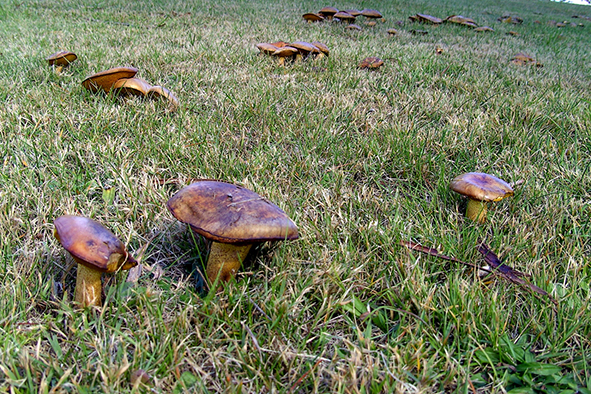
A fairy ring of slippery jacks (Photo: Ian Sutton via Flickr)